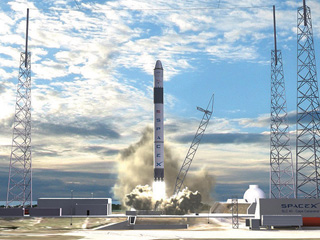 Rocket: Falcon 9 Payload: Dragon Date: June 4, 2010 Window: 11 a.m.-3 p.m. EDT Site: SLC-40, Cape Canaveral, Florida 

|
Mission Status Center
Welcome to Spaceflight Now's live coverage of the inaugural Falcon 9 rocket launching a Dragon test unit on a demonstration flight. Text updates will appear automatically; there is no need to reload the page. Follow us on Twitter. WEDNESDAY, MARCH 10, 2010
A ball of orange flame and cloud of black smoke gushed from the base of the Falcon 9 rocket Tuesday afternoon, but the countdown was aborted a split-second before the booster's nine engines ignited for a crucial ground test.
0345 GMT (10:45 p.m. EST Tues.) The countdown was aborted at about T-minus 2 seconds, just as the rocket's nine Merlin 1C engines were about to fire for a planned 3.5-second burn, according to a written statement released by SpaceX, the private sector operator of the Falcon 9. "Given that this was our first abort event on this pad, we decided to scrub for the day to get a good look at the rocket before trying again," the statement said. "Everything looks great at first glance." Read our full story. 0150 GMT (8:50 p.m. EST Tues.)
SpaceX has provided the following statement after today's static fire attempt:
"Today SpaceX performed our first Static Fire for the Falcon 9 launch vehicle. We counted down to T-2 seconds and aborted on Spin Start. Given that this was our first abort event on this pad, we decided to scrub for the day to get a good look at the rocket before trying again. Everything looks great at first glance." "We completed pad preps on time and with good execution. The integrated countdown with the range included holdfire checks, S-band telemetry, C-band, and FTS simulated checks. We completed helium, liquid oxygen (LOX), and fuel loads to within tenths of a percent of T-zero conditions. Tanks pressed nominally and we passed all Terminal count, flight software, and ground software abort checks right down to T-2 seconds. We encountered a problem with the spin start system and aborted nominally." "As part of the abort, we close the pre-valves to isolate the engines from the propellant tank and purge the residual propellants. The brief flames seen on the video are burn off of LOX and kerosene on the pad. The engines did not ignite and there was no engine fire." "We detanked and safed the vehicle and launch pad. Preliminary review shows all other systems required to reach full ignition were within specification. All other pad systems worked nominally. Inspections will be complete tonight. Tomorrow will consist of data review and procedure updates. Commodities will be replenished tomorrow including TEA-TEB load, LOX and helium deliveries." "We'll look to do the next static fire attempt in three or four days." TUESDAY, MARCH 9, 2010
Nearing four hours after the Falcon 9 static fire, SpaceX has not provided any update on the outcome of the engine test, its duration, whether it was aborted, or when they will try again.
2236 GMT (5:36 p.m. EST) 1927 GMT (2:27 p.m. EST)
Spectators report they heard a loud bang at the time of ignition, but no other prolonged sounds of the engine burning. Visual indications at ignition included a flash of orange light, a cloud of steam and black smoke, and a brief fire at the base of the rocket, which appeared consistent with behavior after an engine cutoff.
1910 GMT (2:10 p.m. EST)
The Falcon 9 engine test is apparently scrubbed for the day.
1906 GMT (2:06 p.m. EST)
Replays of the brief engine firing show the countdown was aborted just as the rocket was ignited.
1857 GMT (1:57 p.m. EST)
SpaceX commonly recycles after an aborted first stage ignition to try again within minutes, if the problem causing the countdown cutoff is minor.
It is unclear whether SpaceX will attempt another ignition this afternoon. Computers monitor parameters in various systems on the rocket and the launch pad during the final seconds of the countdown. Small deviations from expected values can trigger an abort. "We want to set our aborts tighter initially, and we don't want one tight abort to scrub a whole launch day," said Tim Buzza, the Falcon 9 launch director. "The key thing is it's not cavalier, it's thought out. We have rules when we see that abort how we go into an anomaly team and get the engineers to say, OK, it was tight. I'm going to open it up 1 psi," Buzza told Spaceflight Now in a previous interview. 1848 GMT (1:48 p.m. EST)
A reminder that if you will be away from your computer but would like to receive occasional countdown updates, sign up for our Twitter feed to get text message updates on your cellphone. U.S. readers can also sign up from their phone by texting "follow spaceflightnow" to 40404. (Standard text messaging charges apply.)
1844 GMT (1:44 p.m. EST)
The Falcon 9 rocket is again venting liquid oxygen following the apparent brief ignition attempt.
1842 GMT (1:42 p.m. EST)
A flash of fire and smoke was just observed at the base of the Falcon 9 rocket, possibly indicating ignition. But there is no confirmation the engines fired for the full expected duration of 3.5 seconds.
1840 GMT (1:40 p.m. EST)
Standing by for ignition.
1831 GMT (1:31 p.m. EST)
The Falcon 9 engines did not ignite as scheduled at 1:30 p.m. EST.
1825 GMT (1:25 p.m. EST)
In the final minute before the time liftoff would occur, the countdown is on an automated computer-controlled sequence to check thousands of parameters on the rocket and the launch pad.
Final activities include a steering check of the nine first stage engines and propellant tank pressurization. During the last minute before launch, a network of approximately 30 water spigots will release to flood the launch deck with water. Inside T-minus 10 seconds, the water deluge system in the flame trench is activated. The water system dampens the acoustics of engine ignition and liftoff, releasing about 75,000 gallons of water per minute, according to SpaceX engineers. The first stage engine ignition sequence begins a few seconds before launch, including a heavy nitrogen purge of the propulsion unit at T-minus 5 seconds. The Merlin engine turbines start spinning in the turbopumps at T-minus 3 seconds. "What you do is you start the pump because it needs to feed the gas generator. As the pump starts spinning, we light the main chamber at low pressure, then we light the gas generator, which is the powerhead," said Tim Buzza, the Falcon 9 launch director. "When the engine starts, we blast it with helium to get the turbine spinning. And then we also have a high pressure GN2 purge. Those are the two largest ground system things we need to start the first stage, other than the TEA-TEB ignition source," Buzza said. The TEA-TEB, or triethylaluminum-triethylborane, ignition source lights the propellant inside the engines. The engines ramp up to full power by T-minus 1 second. During today's static fire, engine shutdown should occur just after the simulated liftoff time. During the engine test, the rocket will remain firmly attached to the launch pad by four holddown clamps on the launch mount. 1823 GMT (1:23 p.m. EST)
The fully-fueled Falcon 9 rocket is still on schedule for a 3.5-second burn of its nine Merlin engines at 1:30 p.m. EST.
1820 GMT (1:20 p.m. EST)
Critical steps expected to occur in the last 10 minutes of the countdown include the alignment of the internal navigation system, a second stage engine steering check, transferring the rocket to internal power, liquid oxygen system closeouts, and the start of the automated sequence about at about T-minus 90 seconds.
1806 GMT (1:06 p.m. EST)
The Falcon 9 rocket's nine Merlin 1C first stage engines will be ignited today for 3.5 seconds, enough time to verify systems on the ground and the launch vehicle responsible for the final few seconds of the countdown.
The engines will produce about 825,000 pounds of total sea level thrust, about four times the power of a 747 jumbo jet at full throttle. The engines consume about 3,200 pounds of kerosene and liquid oxygen propellants per second, according to SpaceX. "This is analogistic to a run-up an aircraft might do on the runway to verify all systems are functional," said Elon Musk, SpaceX's founder and CEO. "That gives the rocket a nice final shakedown. We will then double-check everything to make sure everything's OK after that short static fire. If it's looking good, then we launch soon thereafter." Liftoff is booked on the range for March 22 between 11 a.m. and 3 p.m. EDT, but SpaceX officials say launch is more likely to occur some time in April. 1752 GMT (12:52 p.m. EST)
The Air Force Eastern Range is supporting today's test activities with SpaceX. Range officials are based in the Range Operations Control Center, or ROCC.
"The launch vehicle does not contain all mission elements at this point; however, we will be supporting the static fire with a majority of the Eastern Range interface with SpaceX, which will be scheduling and conducting a Mission Dress Rehearsal as a milestone to launch, as well an Integrated Crew Exercise," an Air Force spokesperson said in a written statement. "The 45th Space Wing continues to work to support range customers like SpaceX to assure access to the high frontier." 1742 GMT (12:42 p.m. EST)
We are now streaming live video of the Falcon 9 rocket at Complex 40. Hit reload and the video window should appear on the right side of this page.
1739 GMT (12:39 p.m. EST)
A reminder that if you will be away from your computer but would like to receive occasional countdown updates, sign up for our Twitter feed to get text message updates on your cellphone. U.S. readers can also sign up from their phone by texting "follow spaceflightnow" to 40404. (Standard text messaging charges apply.)
1730 GMT (12:30 p.m. EST)
Launch director Tim Buzza gave Spaceflight Now an overview of the Falcon 9 tanking procedures.
"When we start liquid oxygen loading an hour-and-a-half out, we load both stages and we eventually end up with concurrent propellant loading. We'll start both stages at the same time, and we'll get liquid oxygen loaded in," Buzza said. The cold liquid oxygen is used to condition helium pressurant spheres inside the rocket to about -300 degrees Fahrenheit. "We'll probably get to roughly 50 percent load on liquid oxygen, and at that point, our helium spheres are now submerged in liquid oxygen, so we can begin the fast fill of helium. We load helium cryogenically from the ground. We pass it through a nitrogen bath, so that when we go in with fuel, we have less heating and you can really load fuel quite quickly." "We want to take them one at a time," Buzza said. "We usually stagger them roughly 10 or 20 minutes apart. LOX starts in both stages, helium starts in both stages, then fuel." 1711 GMT (12:11 p.m. EST)
The static fire is now scheduled for about 1:30 p.m. EST.
1658 GMT (11:58 a.m. EST)
FUELING BEGINS. Liquid oxygen vapors have begun streaming from the rocket, a sign that the cryogenic oxidizer is now flowing into the Falcon 9.
The liquid oxygen is stored in a 125,000-gallon sphere in the southeast quadrant of Complex 40. The rocket's RP-1 kerosene fuel is kept in cylinder-shaped tanks on the west side of the pad. Engineers plan to load nearly 39,000 gallons of super cold liquid oxygen and almost 25,000 gallons of kerosene fuel into the first stage tanks. About 7,300 gallons of liquid oxygen and 4,600 gallons of kerosene will go into the second stage. The propellants flow into the first stage through the launch mount at the base of the rocket. Kerosene and liquid oxygen will be pumped up the strongback umbilical tower to enter the second stage. Roughly 30 engineers and managers are stationed inside the SpaceX Launch Control Center near the south gate of Cape Canaveral Air Force Station. 1522 GMT (10:22 a.m. EST)
Safety officials are establishing road blocks around Complex 40 as fueling is about to begin for the Falcon 9's static fire, which remains scheduled for around 1 p.m. EST.
1410 GMT (9:10 a.m. EST)
The Falcon 9 static fire is scheduled for 1 p.m. EST today, according to Kirk Shireman, deputy International Space Station program manager.
Shireman is briefing the media today about the upcoming STS-131 space shuttle mission during a series of press conferences in Houston. 1212 GMT (7:12 a.m. EST)
Although SpaceX is tight-lipped about its plans to fire the Falcon 9 rocket's engines today, the strongback at Complex 40 was retracted to its fueling position yesterday and remained there overnight.
MONDAY, MARCH 8, 2010
The engine test has been rescheduled for tomorrow, according to SpaceX.
1515 GMT (10:15 a.m. EST) 1430 GMT (9:30 a.m. EST)
SpaceX just lifted the Falcon 9 rocket vertical at Complex 40, as engineers apparently begin final preparations for a brief test of the booster's nine first stage engines today.
The static fire is scheduled for late this morning or early this afternoon, SpaceX officials tell Spaceflight Now. During the test, the launch team will load propellant into the 154-foot-tall rocket and light the engines at the end of a simulated countdown for about three-and-a-half seconds. FRIDAY, MARCH 5, 2010
Space Coast residents shouldn't expect to hear a thunderous roar emanating from the Falcon 9 rocket until Monday, at the earliest.
SpaceX says the engines at the bottom of the 15-story rocket will be tested no earlier than Monday. The Falcon's first stage includes nine Merlin 1C engines to power the rocket from the launch pad to the edge of space in the first three minutes of flight. The company plans to fire the engines for about three-and-a-half seconds at the end of another practice countdown to exercise the rocket, ground systems and launch team. Engineers loaded propellant into the rocket for the first time at Cape Canaveral during a Feb. 26 wet dress rehearsal. That test ended with a simulated pad abort at T-minus 10 seconds. The Falcon 9 launch is still booked on the Eastern Range for March 22, but the rocket probably won't launch until April, according to SpaceX officials. WEDNESDAY, MARCH 3, 2010
A preflight test of the Falcon 9 rocket's nine Merlin engines could occur as early as this weekend.
SpaceX hoisted the 15-story rocket back vertical on its launch mount at Complex 40 late Wednesday afternoon. The next step in ground testing will be a hotfire of the Falcon 9's first stage engines. The launch team will ignite the nine Merlin 1C engines for three-and-a-half seconds during the test. The hotfire is booked for Saturday on the Eastern Range, the military-run network of communications and tracking assets responsible for every launch from Cape Canaveral. The timing of the countdown and engine test is expected to mirror a real Falcon 9 countdown. Engineers loaded about 75,000 gallons of kerosene and liquid oxygen propellants into the Falcon 9 rocket Friday, successfully simulating a countdown and pad abort. Officials said some ablative cork material coating the outside of the first stage became debonded during the wet dress rehearsal, and the cork will be replaced after the static fire, according to Elon Musk, SpaceX's founder and CEO. The cork serves as a heat shield for the Falcon 9 first stage during re-entry. SpaceX hopes to recover the stage for analysis and potential reuse on future flights. Musk says liftoff of the inaugural Falcon 9 could occur late this month, but launch is more likely some time in April. Read our earlier status center coverage. |
 The Falcon 9 rocket will launch on a test flight. See our photo galleries: Rocket assembly inside hangar | Falcon on the pad | Engines fire for test | Rollout before launch  
Space video for your computer, iPod or big screen TV
Experience the space program like never before become a subscriber today |